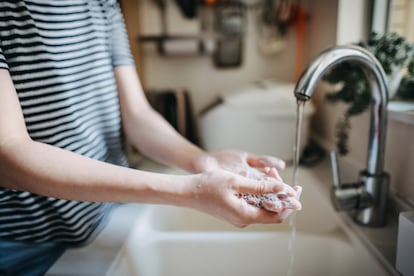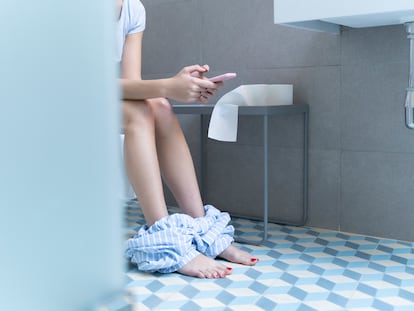Between laziness and germophobia: How often should you wash your hands?
There isn’t an ideal frequency, but excessive handwashing could indicate mysophobia

In late 2023, the New York Post shared survey results on the hygiene habits of university students. The headline declared, “Almost half of Gen Z are ‘germaphobes’ and handwash 10-times or more daily,” prompting a flurry of online conversations about what’s considered normal hygiene.
“I don’t find it alarming to wash 10 times a day or more,” said Mireia Cantero, a Spanish public health professional. After all, it’s “the most effective way to prevent infection.” The whole world learned that painful lesson during the Covid-19 pandemic. Handwashing reduces respiratory infections and prevents diarrhea. Studies show improved school attendance during flu season when children are encouraged to wash their hands thoroughly.
As for how often to wash your hands or use hand sanitizer, Cantero says the situation is more important than the frequency. “Wash your hands after using the bathroom, before eating and cooking, when they’re dirty, and after blowing your nose,” she said. Doing all that could easily mean 10 or more hand washes a day.
The data reveals a concerning trend. A survey by the YouGov Omnibus market research firm shows that a quarter of Spaniards admit to skipping handwashing after using the bathroom. Although handwashing recommendations haven’t changed since the pandemic, there has been an overall decline in handwashing hygiene. “Unfortunately, this is one of the lessons that have been forgotten,” said Cantero.
How much is too much?
Frequent handwashing is crucial for good hygiene, but excessive washing can lead to issues like dermatitis, dryness and invisible skin lesions. These conditions used to be common among healthcare workers due to their frequent handwashing, says Cantero. “Before, there were no alcohol-based hand sanitizers, so everyone used water and soap, which is more irritating. This led to many dermatitis issues among healthcare professionals. Soaps weren’t as good either, and the powder inside the gloves also affected the skin.” However, most people would need to wash excessively or have unusually sensitive skin to experience these issues, says Cantero, and people lean towards washing less rather than more.
However, there are instances where excessive handwashing masks an issue, like what the New York Post called germophobia (or mysophobia). Psychologist Manuel Oliva defines this condition as “an intense and irrational fear of germs, dirt and contamination.” Moreover, it’s not always just about a fear of germs — it can also be associated with obsessive-compulsive disorder (OCD). Worrying about germs doesn’t have to be a problem. “We all worry about picking up germs in dirty places. Basic cleanliness just makes us feel safer and aligns with what we learned as kids about good hygiene,” said Oliva.
The problem arises when fear takes over. When thoughts of contamination occur frequently and lead to excessive washing or prevention behaviors that disrupt daily life and cause high anxiety, it’s considered a pathological fear. “Avoiding dirty places, excessive cleaning, overusing disinfectants, obsessive handwashing, refraining from sharing items, avoiding physical contact, and shunning crowds or animals are behaviors associated with germophobia,” said Oliva. Mireia Cantero says that the important thing is to think about whether the situation requires handwashing. “If it’s necessary, do it. It becomes compulsive when you wash your hands excessively, even when it’s not needed.”
Lastly, Cantero advises seeking a healthy balance. “Living without microorganisms is impossible and not beneficial. The world is not sterile. While it’s good to practice hand hygiene to prevent infections, remember that eradicating all microorganisms is unnecessary and not advised. Focus on risky situations and avoid touching your mouth and other areas when you come into contact with germs.”
Sign up for our weekly newsletter to get more English-language news coverage from EL PAÍS USA Edition
Tu suscripción se está usando en otro dispositivo
¿Quieres añadir otro usuario a tu suscripción?
Si continúas leyendo en este dispositivo, no se podrá leer en el otro.
FlechaTu suscripción se está usando en otro dispositivo y solo puedes acceder a EL PAÍS desde un dispositivo a la vez.
Si quieres compartir tu cuenta, cambia tu suscripción a la modalidad Premium, así podrás añadir otro usuario. Cada uno accederá con su propia cuenta de email, lo que os permitirá personalizar vuestra experiencia en EL PAÍS.
¿Tienes una suscripción de empresa? Accede aquí para contratar más cuentas.
En el caso de no saber quién está usando tu cuenta, te recomendamos cambiar tu contraseña aquí.
Si decides continuar compartiendo tu cuenta, este mensaje se mostrará en tu dispositivo y en el de la otra persona que está usando tu cuenta de forma indefinida, afectando a tu experiencia de lectura. Puedes consultar aquí los términos y condiciones de la suscripción digital.
More information
Archived In
Últimas noticias
Welcome to the post-religion era: The idea of Christianity as the absolute truth has become obsolete
‘I thought you would like it’: The risky sexual practice popularized by TV shows and TikTok
The digitalization of tourism: ‘They promise experiences and gave us the worst possible one’
Mexican peso defies uncertainty with forecasts of a new period of stability in 2026
Most viewed
- Sinaloa Cartel war is taking its toll on Los Chapitos
- Reinhard Genzel, Nobel laureate in physics: ‘One-minute videos will never give you the truth’
- Oona Chaplin: ‘I told James Cameron that I was living in a treehouse and starting a permaculture project with a friend’
- Why the price of coffee has skyrocketed: from Brazilian plantations to specialty coffee houses
- Silver prices are going crazy: This is what’s fueling the rally










































